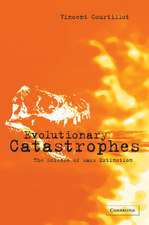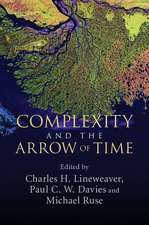The Paleobiological Revolution: Essays on the Growth of Modern Paleontology
Editat de David Sepkoski, Michael Ruseen Limba Engleză Paperback – 16 mar 2015
The Paleobiological Revolution chronicles the incredible ascendance of the once-maligned science of paleontology to the vanguard of a field. With the establishment of the modern synthesis in the 1940s and the pioneering work of George Gaylord Simpson, Ernst Mayr, and Theodosius Dobzhansky, as well as the subsequent efforts of Stephen Jay Gould, David Raup, and James Valentine, paleontology became embedded in biology and emerged as paleobiology, a first-rate discipline central to evolutionary studies. Pairing contributions from some of the leading actors of the transformation with overviews from historians and philosophers of science, the essays here capture the excitement of the seismic changes in the discipline. In so doing, David Sepkoski and Michael Ruse harness the energy of the past to call for further study of the conceptual development of modern paleobiology.
Preț: 355.08 lei
Nou
Puncte Express: 533
Preț estimativ în valută:
67.96€ • 70.41$ • 56.71£
67.96€ • 70.41$ • 56.71£
Carte tipărită la comandă
Livrare economică 22 martie-05 aprilie
Preluare comenzi: 021 569.72.76
Specificații
ISBN-13: 9780226275710
ISBN-10: 022627571X
Pagini: 568
Ilustrații: 29 halftones, 13 line drawings, 6 tables
Dimensiuni: 152 x 229 x 38 mm
Greutate: 0.77 kg
Editura: University of Chicago Press
Colecția University of Chicago Press
Locul publicării:Chicago, IL
ISBN-10: 022627571X
Pagini: 568
Ilustrații: 29 halftones, 13 line drawings, 6 tables
Dimensiuni: 152 x 229 x 38 mm
Greutate: 0.77 kg
Editura: University of Chicago Press
Colecția University of Chicago Press
Locul publicării:Chicago, IL
Notă biografică
David Sepkoski is a senior research scholar at the Max Planck Institute for the History of Science. He is the author of Rereading the Fossil Record: The Growth of Paleobiology as an Evolutionary Discipline, also published by the University of Chicago Press. Michael Ruse is the Lucyle T. Werkmeister Professor of Philosophy and director of the Program in the History and Philosophy of Science at Florida State University. He is the author or editor of nearly thirty books, including The Gaia Hypothesis: Science on a Pagan Planet, also published by the University of Chicago Press.
Cuprins
Acknowledgments
Introduction: Paleontology at the High Table
Michael Ruse and David Sepkoski
Part I: Major Innovations in Paleobiology
1. The Emergence of Paleobiology
David Sepkoski
2. The Fossil Record: Biological or Geological Signal?
Michael J. Benton
3. Biogeography and Evolution in the Early Paleozoic
Richard A. Fortey
4. The Discovery of Conodont Anatomy and Its Importance for Understanding the Early History of Vertebrates
Richard J. Aldridge and Derek E. J. Briggs
5. Emergence of Precambrian Paleobiology: A New Field of Science
J. William Schopf
6. Dinosaurs at the Table
John R. Horner
7. Ladders, Bushes, Punctuations, and Clades: Hominid Paleobiology in the Late Twentieth Century
Tim White
8. Punctuated Equilibria and Speciation: What Does It Mean to Be a Darwinian?
Patricia Princehouse
9. Molecular Evolution vis-à-vis Paleontology
Francisco J. Ayala
Part II: The Historical and Conceptual Significance of Recent Paleontology
10. Beyond Detective Work: Empirical Testing in Paleontology
Derek Turner
11. Taxic Paleobiology and the Pursuit of a Unified Evolutionary Theory
Todd A. Grantham
12. Ideas in Dinosaur Paleontology: Resonating to Social, Political, and Popular Context
David E. Fastovsky
13. Reg Sprigg and the Discovery of the Ediacara Fauna in South Australia: Its Approach to the High Table
Susan Turner and David Oldroyd
14. The Morphological Tradition in German Paleontology: Otto Schindewolf, Walter Zimmermann, and Adolf Seilacher
Manfred D. Laubichler and Karl J. Niklas
15. “Radical” or “Conservative”? The Origin and Early Reception of Punctuated Equilibrium
David Sepkoski
16. The Shape of Evolution: The MBL Model and Clade Shape
John Huss
17. Ritual Patricide: Why Stephen Jay Gould assassinated George Gaylord Simpson
Joe Cain
18. The Consensus That Changed the Paleobiological World
Arnold I. Miller
Part III: Reflections on Recent Paleobiology
19. The Infusion of Biology into Paleontological Research
James W. Valentine
20. From Empirical Paleoecology to Evolutionary Paleobiology: A Personal Journey
Richard Bambach
21. Intellectual Evolution Across an Academic Landscape
Rebecca Z. German
22. The Problem of Punctuational Speciation and Trends in the Fossil Record
Anthony Hallam
23. Punctuated Equilibrium versus Community Evolution
Arthur J. Boucot
24. An Interview with David M. Raup
Edited by David Sepkoski and David M. Raup
25. Paleontology in the Twenty-First Century
David Jablonski
26. Punctuations and Paradigms: Has Paleobiology Been through a Paradigm Shift?
Michael Ruse
List of Contributors
Index
Introduction: Paleontology at the High Table
Michael Ruse and David Sepkoski
Part I: Major Innovations in Paleobiology
1. The Emergence of Paleobiology
David Sepkoski
2. The Fossil Record: Biological or Geological Signal?
Michael J. Benton
3. Biogeography and Evolution in the Early Paleozoic
Richard A. Fortey
4. The Discovery of Conodont Anatomy and Its Importance for Understanding the Early History of Vertebrates
Richard J. Aldridge and Derek E. J. Briggs
5. Emergence of Precambrian Paleobiology: A New Field of Science
J. William Schopf
6. Dinosaurs at the Table
John R. Horner
7. Ladders, Bushes, Punctuations, and Clades: Hominid Paleobiology in the Late Twentieth Century
Tim White
8. Punctuated Equilibria and Speciation: What Does It Mean to Be a Darwinian?
Patricia Princehouse
9. Molecular Evolution vis-à-vis Paleontology
Francisco J. Ayala
Part II: The Historical and Conceptual Significance of Recent Paleontology
10. Beyond Detective Work: Empirical Testing in Paleontology
Derek Turner
11. Taxic Paleobiology and the Pursuit of a Unified Evolutionary Theory
Todd A. Grantham
12. Ideas in Dinosaur Paleontology: Resonating to Social, Political, and Popular Context
David E. Fastovsky
13. Reg Sprigg and the Discovery of the Ediacara Fauna in South Australia: Its Approach to the High Table
Susan Turner and David Oldroyd
14. The Morphological Tradition in German Paleontology: Otto Schindewolf, Walter Zimmermann, and Adolf Seilacher
Manfred D. Laubichler and Karl J. Niklas
15. “Radical” or “Conservative”? The Origin and Early Reception of Punctuated Equilibrium
David Sepkoski
16. The Shape of Evolution: The MBL Model and Clade Shape
John Huss
17. Ritual Patricide: Why Stephen Jay Gould assassinated George Gaylord Simpson
Joe Cain
18. The Consensus That Changed the Paleobiological World
Arnold I. Miller
Part III: Reflections on Recent Paleobiology
19. The Infusion of Biology into Paleontological Research
James W. Valentine
20. From Empirical Paleoecology to Evolutionary Paleobiology: A Personal Journey
Richard Bambach
21. Intellectual Evolution Across an Academic Landscape
Rebecca Z. German
22. The Problem of Punctuational Speciation and Trends in the Fossil Record
Anthony Hallam
23. Punctuated Equilibrium versus Community Evolution
Arthur J. Boucot
24. An Interview with David M. Raup
Edited by David Sepkoski and David M. Raup
25. Paleontology in the Twenty-First Century
David Jablonski
26. Punctuations and Paradigms: Has Paleobiology Been through a Paradigm Shift?
Michael Ruse
List of Contributors
Index
Recenzii
“The utter transformation of paleontology over the past forty years is too often viewed as either obvious and inevitable (by its enthusiasts), or misguided and unimportant (by its critics). Both of these extreme views could be avoided by a greater familiarity with the history of this revolution, which is unfortunately viewed by most professionals as of merely antiquarian interest, and this sense has been passed on to our students. The varied chapters in this fine volume provide an excellent antidote to this situation. Every paleontologist, and especially every graduate student, should read this book!"
“Sepkoski and Ruse have assembled a wonderfully rich collection of essays that looks at diverse aspects of current science and provides sophisticated reflection on leading actors, probing historical and philosophical analyses, and important interpretations by the contributors. This is an important contribution to our understanding of scientific change generally as well as paleobiology and evolution specifically.”
“Paleontologists are indeed back at the high table of evolutionary theorists, as this splendid book vividly demonstrates. With its mix of retrospective reviews and analyses of recent developments, the book gives us rich materials for evaluating what surely deserves to be called a scientific revolution. As a paleontologist, back in the 1960s I was excited by the first stirrings of the new paleobiology; now, as a historian, I'm delighted to see such a fine volume on what it has since become, and how it got there.”
“Tom Schopf elevated the term paleobiology to new heights when he assembled his 1972 book Models in Paleobiology and spearheaded the founding of the journal Paleobiology—a journal, I am happy to say, that is read by many who do not work directly with fossils. If there is still some distance to go before paleobiology is fully integrated with evolutionary theory, the importance of the fossil record in understanding—not only the course of evolution, but also its pulse and pace, and even some of its mechanics—is nonetheless undeniable. The twenty-six papers in this volume probe the early days of this resurgence, and capture some of the excitement rippling through the field as paleontologists rediscovered the powerful evolutionary implications of their data.”
“Sepkoski and Ruse’s volume opens up the door to a long-neglected area in the history of evolutionary biology, one that began with Darwin and after a long period of eclipse has come back to illuminate a wide variety of macro- and microevolutionary processes.”
“The twenty-six scholarly essays in The Paleobiological Revolution document and celebrate the rise of paleobiology—paleontology as a biological science—which established the study of the fossil record as a unique contributor to evolutionary biology. Fossils became considered as once-living organisms with real physiologies and ecologies, populating ancient environments and forming ecosystems that may have no close modern analogs. . . . In this volume we find the scientific bones of the paleobiology revolution carefully examined both by historians of science and as personal accounts from many of those who played a part in shaping the transformation. Together they tell the tale, heralded by John Maynard Smith, of the return of paleontologists to the ‘high table’ of evolutionary biology.”
"This invaluable volume – a must read for anyone interested in evolutionary theory or twentieth century biology and paleontology – may be the first word on the history of the paleobiological revolution, but it is certainly not the last."
“A stimulating and eminently readable, historical account of the revolution in paleontology and the emergence of the field that became known as paleobiology.”
“This insightful volume should serve as a foundation for future work in the largely unexplored realm of history and philosophy of paleontology.”















